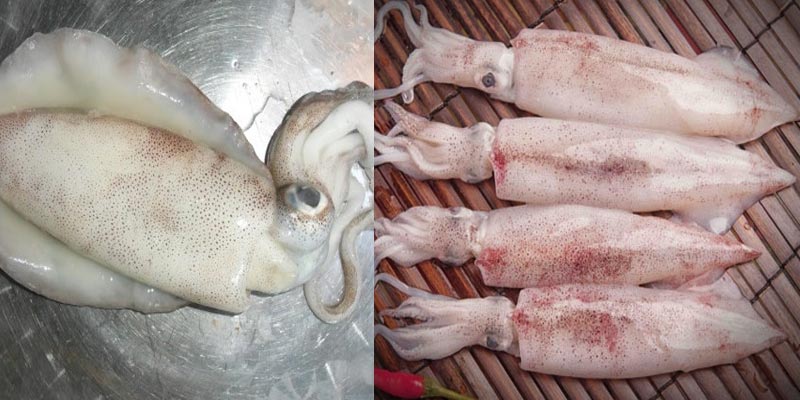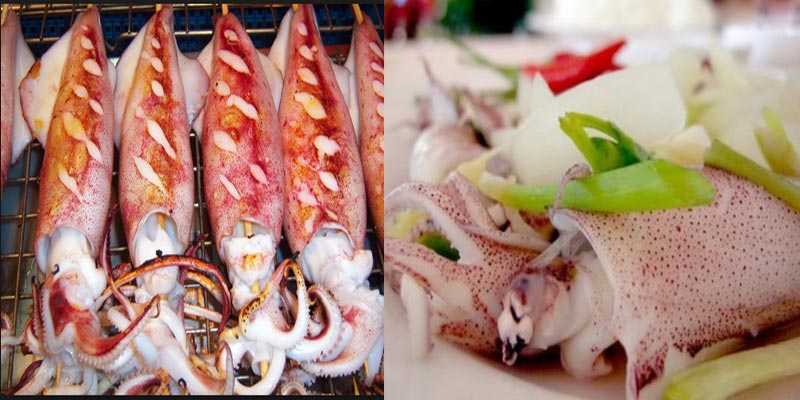Squid is a delicious and versatile seafood beloved by many. It is not only a rich source of nutrients but also offers potential health benefits, including reducing the risk of joint inflammation, promoting heart health, and supporting relaxation of the nervous system, which can help alleviate migraine symptoms. The two most common types of squid found in the market are tube squid and leaf squid, both of which are equally tasty and nutritious. But how do they differ, and which one should you choose for your dishes? Let’s find out.
1 How to Distinguish Between Leaf Squid and Tube Squid

Characteristics
Tube squid, as the name suggests, has a long, cylindrical body resembling a tube. Its tail end is thinner, and its fins are shorter compared to the leaf squid. Tube squid is distinguished by its eight small tentacles and two long arms, with a spotted pinkish skin and large, translucent eyes. The unique feature of this squid is its tail fin, which extends from the middle to the end of its body, forming a diamond shape.
On the other hand, leaf squid has long “ears” that extend to the end of its body, giving it a leaf-like appearance when swimming. Its fins are thick, wide, and oval-shaped, running from the head to the middle of its body. The body of the leaf squid is slightly flatter and shorter than that of the tube squid.
Meat Quality
When it comes to meat quality, leaf squid tends to have firmer and chewier meat than tube squid. Tube squid meat is known for its crispness and melt-in-your-mouth texture, but it lacks the sweetness and thickness of leaf squid meat. Leaf squid, on the other hand, has thicker and crispier meat with a distinct sweet flavor.
Preparation and Cooking
Due to its natural sweetness, leaf squid is often used for making dried squid or as an ingredient in stir-fries and steamed dishes such as g, …, among others. The sweetness of the meat, along with its crisp texture, makes it a delicious and flavorful addition to these dishes.
For stir-frying tips, check out: .
While tube squid may not have the same level of sweetness, its crisp texture makes it ideal for fried dishes, hot pots, and stuffed squid recipes. Tube squid is also a favorite among chefs for garnishing dishes, as its cooked rings look beautiful on a plate.
2 Leaf Squid or Tube Squid: Which One to Choose?
Squid, in general, is a highly nutritious seafood, packed with protein and essential minerals like riboflavin, vitamin B12, phosphorus, copper, and selenium. However, it is also high in cholesterol, so moderation is key. When it comes to choosing between leaf squid and tube squid, the decision depends on your preferred method of preparation and cooking.

For example, if you’re planning to stir-fry, steam, or stuff squid, tube squid is the better choice as it not only tastes great but also presents well on a plate. On the other hand, if you want to explore a wider range of cooking methods, such as hot pot or grilling, leaf squid is the way to go. Its thicker body and natural sweetness make it ideal for these cooking styles.
For more information:
Note: When selecting leaf squid, opt for larger specimens with thick, firm bodies and intact, rigid tentacles. Fresh leaf squid should have hard, unyielding flesh. As for tube squid, choose specimens with bright pink meat, heads firmly attached to the body, and intact ink sacs to ensure freshness and optimal taste.
Seafood Prices Soar as High as Multiple Millions in Vietnam Markets
Have you ever tried the deliciously tantalizing sea worms? These highly sought-after seafoods can fetch prices of up to several million dong. Let’s dive deeper into this fascinating seafood dish.






































